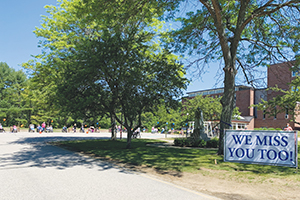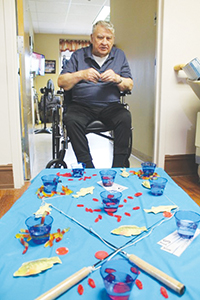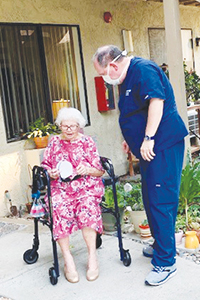By JULIE MINDA
When the Centers for Medicare and Medicaid Services advised March 13 that all long-term care facilities strictly limit visitation and communal activities, few could have foreseen that the restrictions would stretch into late summer and beyond.

Long-term care facilities have been organizing engaging events to help residents remain connected to their loved ones in the midst of the pandemic. Here, residents await a car parade this summer at St. Andre Health Care in Biddeford, Maine, part of Covenant Health.
Residents in eldercare facilities across the U.S. have spent months living lives that are much more isolated and constricted than they were pre-pandemic. And, while facilities in states and localities that have eased restrictions have been resuming visits and communal activities on a limited basis, visitation remains very limited even in those sites. Eldercare experts from around the Catholic health ministry say their facilities have been concerned about the impact of the isolation on their residents and have been diligent in seeking ways to ease that isolation.
Debbie Scionti is mission and values director for D'Youville Life and Wellness Community in Lowell, Massachusetts, which is sponsored by the Carmelite Sisters for the Aged and Infirm. She says the restrictions had resulted in residents living almost as shut-ins, and she had worried the lack of stimulation and human contact was negatively impacting some residents' cognition and their desire to thrive.

Dean Suffrins, a resident at Benedictine Living Community Winona in Minnesota, plays a game devised by recreation staff to keep residents entertained and stave off boredom, loneliness and isolation.
But, Scionti notes, on June 12 D'Youville resumed some spatially distanced dining and communal activities, and it opened up visitation on a very limited basis — visits are done outdoors with staff present to ensure social distancing is maintained. And, in mid-September, the facility was awaiting health department guidelines on how to move the visits indoors when cold temperatures arrive. Scionti says that even the limited in-person contact with loved ones has helped to lift spirits and made the residents feel more connected to their families. And she says the increased social activity generally has helped residents and staff to feel "like our normal selves."
Still distant
While some facilities have slowly resumed some level of in-person visitation, others are not yet ready. For instance, while Florida Gov. Ron DeSantis issued an executive order Sept. 1 easing restrictions on in-person visitation in long-term care sites. Catholic Health Services of Lauderdale Lakes expected to resume face-to-face visits the week of Sept. 20. Bon Secours St. Petersburg Health System planned to resume face-to-face visits on Sept. 21.
Representatives of those systems say while workarounds like drive-thru visits and window visits have been enabling residents to see family members live, the residents still were longing for closer contact with family and friends.
Fr. Edmund Aku is pastoral care director at St. Anne's Nursing Center & Residence of Miami, part of Catholic Health Services. He says that many frail elders are in long-term care settings because of decreased mental ability, limited mobility and diminished independence. "These factors minimize their ability to cope with sudden changes that last for a protracted time, like they are now experiencing."
Kip F. Corriveau, director of mission at Bon Secours St. Petersburg Health System in Florida, agrees that nursing home residents with dementia and other cognitive impairments are especially vulnerable to the impacts of pandemic-related restrictions. This is because many of them rely on the comfort of familiar settings and familiar people, and they need the social cues of familiar voices and facial expressions. With residents and staff wearing masks, facial expressions are obscured and voices are muted, he says.
Restrictive visitation and socialization policies "have had a tremendous mental effect on our residents," says Jamie Bonavita-Rhodes, administrator of Catholic Health Services' St. Joseph Residence of Lauderdale Lakes, an assisted living community.
The residents understand that the restrictions are for their protection, since frail elderly are the most vulnerable population with regards to this virus. But when weeks of family separation turned into months, loneliness and depression began to set in. "They have had enough," Bonavita-Rhodes says.
Stimulation
Long-term care facilities, including those represented here, have tried to bridge the gap created by the restrictions. They have increased their use of videoconferencing to allow for virtual visits with loved ones. They've ensured access to Masses through closed circuit television and other mediums. And, they've modified recreational therapies and other activities, including by using social distancing in group rooms or employing technology that allows individuals to participate in their private rooms.
However, says Bonavita-Rhodes, "all the technology in the world cannot make up for a physical touch from a loved one.
"It is the little things we always took for granted — we are now realizing how truly important a hug from a loved one is, or a chat with a neighbor that you can sit next to, and even just getting a haircut to make one feel good about themselves," she says.
Many eldercare staff around the ministry are seeing their role in a broader way than before, says Scionti of D'Youville. "We've always considered ourselves a family, but that has taken on a whole new context now that we are the only family" that residents can see in-person on a regular basis. Staff are making more time for personal interactions with residents; making extra efforts to take residents outside, which can have a restorative effect; and engaging residents in conversation about favorite topics.
Assessment
At Bon Secours St. Petersburg facilities, says Corriveau, all team members monitor residents' social, emotional, mental and spiritual well-being on an ongoing basis. At daily meetings, those team members discuss which residents need support most and what type of support would be warranted.
Sondra Norder is president and chief executive of St. Paul Elder Services of Kaukauna, Wisconsin. The Franciscan Sisters of Christian Charity Sponsored Ministries facility resumed visitation in late June but has since had to discontinue visitation amid a COVID outbreak. Visitation had not yet resumed as Catholic Health World went to press in mid-September.
Norder says all her staff is trained to be "expert noticers" when it comes to residents' emotional well-being. If frontline staff detect worrying behavior or symptoms among residents, including lack of appetite, tearfulness and disinterest in activities they once loved, those staff can discuss the issues with a multidisciplinary team.
The team might modify care plans, such as by increasing the residents' social interaction, implementing medication therapy as warranted or initiating talk therapy. The facility has access to outside geriatric psychiatrists who can assist. Norder says St. Paul focuses on providing trauma-informed therapies, since much of what the residents are experiencing is traumatic. Such therapies involve understanding, acknowledging and verbally addressing the source of trauma — which in this case is the isolation.
Norder says, "We can't prevent all heartache. But it's our mission to do the right thing" for the residents, including trying to protect their well-being.
Scionti of D'Youville says the chaplain and social work teams have had a crucial role to play in the important work of addressing the psychosocial fallout of isolation. "We're paying attention to those most in need."
Prior Catholic Health World coverage of loneliness and the impact on the elderly:
https://www.chausa.org/publications/catholic-health-world/archives/issues/september-1-2018/building-connections-to-fend-off-the-health-effects-of-loneliness
https://www.chausa.org/publications/catholic-health-world/archives/issues/july-online/isolation-loneliness-take-their-toll-during-the-covid-19-pandemic
https://www.chausa.org/publications/catholic-health-world/archives/issues/september-1-2020/eldercare-staff-keep-the-good-times-rolling-amid-lockdowns
https://www.chausa.org/publications/catholic-health-world/archives/issues/september-1-2020/eldercare-staff-keep-the-good-times-rolling-amid-lockdowns#kindness
National Academies sees opportunity for providers to address isolation
St. Jude Medical has programs in place to reduce isolation among senior adults
In February, the National Academies of Sciences, Engineering and Medicine issued a report detailing how social isolation can harm older adults and recommending approaches for reducing loneliness.

Mark Pennington, a volunteer with the "Cheer-A-Senior" program, visits with program client Peggy Coked after bringing groceries to her home. St. Jude Medical Center of Fullerton, California, created the Cheer-A-Senior program to reduce isolation among seniors in Orange County, California, amid the pandemic. St. Jude is part of Providence St. Joseph Health.
The report, "Social Isolation and Loneliness in Older Adults: Opportunities for the Health Care System," says social isolation and loneliness can put seniors at higher risk of dementia, depression, heart disease and early death.
The authors say that older adults have a higher probability of experiencing social isolation and loneliness than people in other age groups, because they are more likely to live alone, to have survived the death of loved ones, to have chronic illness or to have sensory impairments — and all of these are predisposing factors for social isolation and loneliness.
A National Academies committee developed the report, with support from the AARP Foundation. A press release announcing the report says the health care system "remains an underused partner in preventing, identifying and intervening for social isolation and loneliness among adults over age 50."
The study recommends that clinical care providers conduct assessments to identify at-risk individuals, include social isolation measures in electronic health records and connect patients with social or community programs that can address isolation and loneliness. The report mentions that technology used to enable home monitoring of patients can in fact be a contributing factor in isolating them.
The report calls for more research on social isolation and more action at the community level to stem it.
One ministry member taking on the issue of isolation among senior adults is St. Jude Medical Center in Fullerton, California, part of Providence St. Joseph Health. Karyl Dupée is clinical supervisor of senior services and community care navigation for the medical center.
She says research shows that loneliness among senior adults is linked to increased fall risk, increased use of emergency centers and urgent care centers, anxiety and depression, dementia and suicide among older adults. Senior adults who are lonely can forget to take needed medications. They also are at increased risk of being the victim of elder abuse and scams, she says.
Among the programs Dupée has developed at St. Jude to reduce isolation among seniors is a visitation program called "Caring Neighbors." Volunteers who pass a background screening pay social visits to senior adults and assist with basic needs, such as carrying laundry up the stairs, or with errands.
That program is on temporary hold amid the pandemic. But St. Jude created another program in its place. The "Cheer-A-Senior" program has screened and trained volunteers who place weekly phone calls to senior adults to check in and chat. The volunteer team also can do grocery runs and medication pickups and can help the clients to access community resources they may need, like support groups. Upwards of 70 volunteers — including St. Jude staff, college interns and graduate students — serve more than 400 senior adults.
As part of the program, the volunteers also administer a depression and anxiety survey every quarter. Anecdotal evidence and these assessment results among clients show that elders can be at increased risk of loneliness amid the pandemic, says Dupée.
— JULIE MINDA
Government agencies urge caution in reopening visitation in long-term care facilities
On March 13, the Centers for Medicare & Medicaid Services tightened its guidance for controlling and preventing COVID-19 in nursing homes. All facilities nationwide were directed to close their doors to all visitors and nonessential health care personnel.
The limited exception would be for compassionate visits, such as with a dying patient, but even then, CMS recommended no hugging or physical contact. At the time, no one could foresee the restrictions would stretch into the late summer and beyond.
Along with visitation, CMS had advised against communal dining and all group activities in order to lower the risk of viral contagion, which was taking its heaviest toll among the frail elderly in nursing homes.
According to AARP, by mid-May the federal government asked governors to proceed with "extreme caution" and make nursing homes among the last facilities to reopen in communities. While many facilities restarted some activities with social distancing protocols in the spring and summer and allowed families to visit through closed exterior windows, in a socially distanced drive-by, or outdoors, there still are many limitations on visitation. Cold months and flu season loom.
As the coronavirus case numbers have fallen, most states have issued guidelines on how facilities can offer very limited visitation in nursing homes. As of Sept. 17, only five states were still prohibiting visitation, according to an AARP tool.